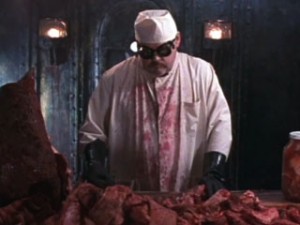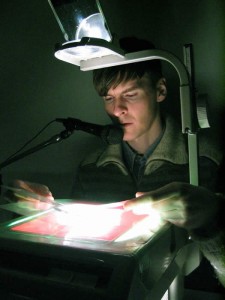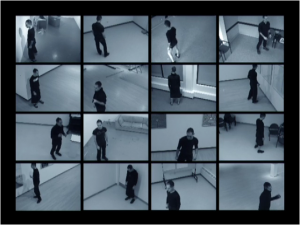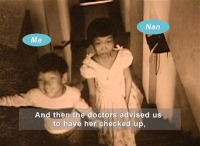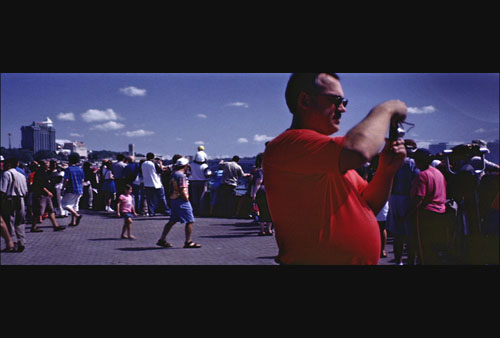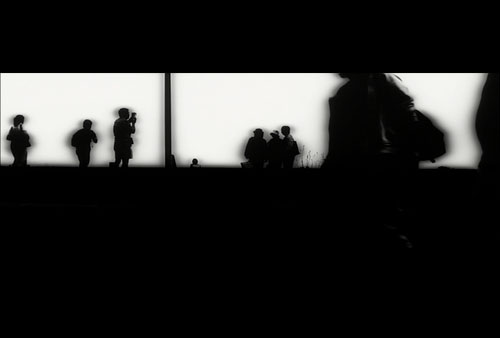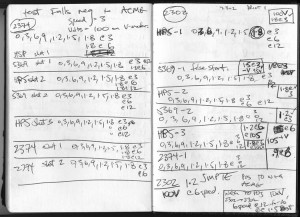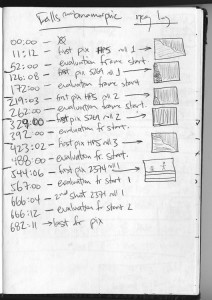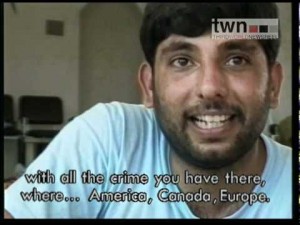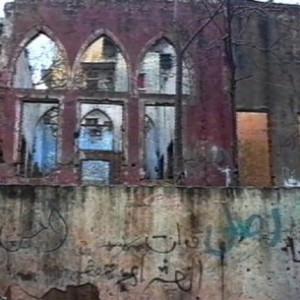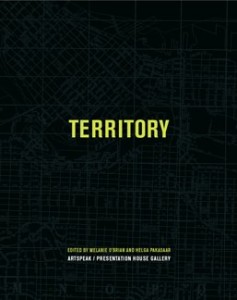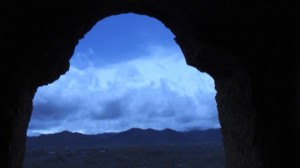
Winnipeg Cinematheque, February 20, 2009
Both Sides Now (program 1) Practical Dreamers Launch
Under Chad Valley by Jeff Erbach 8:30 minutes 1998
Live to Tell by Benny Nemerofsky Ramsay 6 minutes 2002
Black Heart’s Desire by Daniel Barrow 5 minutes 1995
Sea in the Blood by Richard Fung 26 minutes 2001
Under Chad Valley by Jeff Erbach 8:30 minutes 1998
There used to be an underground reserved for movies like this, with its wordless butchers and all-meat décor. Butcher one makes a wordless sexual advance, while the other, distracted by the prospect of having a body again, chops the end of his finger off. Mute and hungry girls look on, wondering when it will be their turn to feed. Photographed with all the luxury of a big car feel, this beautiful jewel of a film threatens at every moment to burst out into the story of my life, before retreating back into its secret codes.
Black Heart’s Desire by Daniel Barrow 5 minutes 1995
“In my thesis year I asked everyone I knew to draw a picture of me picking a rose from a bush, especially those with naïve rendering skills. This was in the early 90s and the burgeoning of “tard art.” I animated these drawings in Black Hearts Desire.” (DB)
Live to Tell by Benny Nemerofsky Ramsay 6 minutes 2002
This artist had two perfect years and has been working to relearn the stroke ever since. Here he channels Madonna into a multi-screen surveillance video, casually janitor dancing in between a capella turns. Choruses of his beautiful self ebb and gather. The singing is so beautiful, so calculatingly off-hand, so heartfelt in an emo, shoegazy sort of way, that even Madonna didn’t have the heart sue him.
Sea in the Blood by Richard Fung 26 minutes 2001
The unlikeliest diary maker of the fringe returns with a movie that raised the stakes for video art in this country. Not only is this the most personal work the artist has ever convened, it is also his most urgent and lyrical and lush. In this brilliant summary work, Fung lays down a duet of his sister’s fatal illness and his own lifelong romance with Tim, an AIDS activist with an illness of his own to contend with. The personal is always and necessarily political in these mosaic recountings which never shirk from the task of unsettling received wisdoms.
Winnipeg Cinematheque, February 21, 2009
Both Sides Now (program 2)
View of the Falls from the Canadian Side by John Price 7 minutes silent 2006, 35mm, Canada
Talaeen a Junuub/Up to the South by Jayce Salloum and Walid Ra’ad, 60 minutes, 1992
View from the other side of the Falls by John Price 7 minutes silent 2006, 35mm, Canada
“A film commissioned by LIFT (Liaison of Independent Filmmakers of Toronto–a film production co-op) for its Film is Dead-Long Live Film omnibus project. In 1896, William Heise photographed the first 35mm motion picture images of Canada at Niagara Falls. The 4 perforation camera system he used was designed and built by Thomas Edison and William K. Dickson. The stock was manufactured by George Eastman to Edison’s specifications. This film was photographed using essentially the same technology and is dedicated to the visionary ideas of those pioneers.” (John Price)
Shot with a small, hand-cranked, 35mm camera, Price visits a tourist’s playground and returns with the mystery intact. Instead of using his camera as a shield, to protect himself from seeing, here he strips away the layers of culture and artifice and returns us, in a sublime chemical reworking, to a primal scene of witness. Those vast supernal bodies of light: they’re us!
The opening gesture is in colour, in a wide screen extravagance that turns watchers into watched. The tourists have gathered round the world to gape, and owing to John’s chemical magics they appear reconfigured, touched, and transformed. They have come with their large bellies and small digital cameras to try to keep a distance, to try to keep the miracle from happening. But what is astonishing about the Falls, viewed and reviewed on postcards and T-shirts and Marilyn Monroe movies, is that the encounter itself strips all of that away. Some old wonder continues, and by running the footage through his chemical soaked hands, John adds a devastating light that comes up out of the watery cascade.
When the tourists are released, after a single camera roll, the Falls appear in black and white in single rolls arriving out of a soft focused haze, and then dissolving back into it (which permits the processing marks, in watery baths of a different kind, to be seen more clearly.) How to see what has been seen too often, how to make visible what becomes invisible not via repression, but through overexposure? The steady pulse of these pictures, turning in and out of the focal plane, allows the Falls to become visible, exactly because they are so fragile and momentary; this small window of focus is already slipping away even as it appears. I accompanied John on one of these excursions, and it was a mid-afternoon delight to see him set up his small wooden box of a camera, entirely blind (there is no way to see “through” the camera”, rather, it is pointed towards the subject in wide-angle hope), steadily cranking the film through the device after looking and looking again. I think he exposed two rolls that day, a couple of minutes at most, which were taken home and processed in his basement. That was the beginning of his camera visitations, the movie took shape as a result of the evidence, the encounter, the act of seeing with his own eyes. Editing meant cutting these rolls together, end to end, in between playing with his son Charlie and his daughter Estelle. The wonder of their appearance arrives in the basement chemistry because he is busy all day letting them teach him how to see, how to turn the neighbourhood into small wonders just like this. A crack in the concrete. A patch of grass folded back, leaving the impression of a head. The cataract of water. In the final roll of the film the spectators leave, rendered in high contrast black and white, their bodies glowing with the charge of all they’ve seen. Then it’s time to go home and live those miracles.
Talaeen a Junuub/Up to the South by Jayce Salloum and Walid Ra’ad, 60 minutes, 1992
When I was growing up, there was a moment in the televised portion of the evening, following dinner, that was reserved for Vietnam. Hundreds of hours were spent in this colonial convening, but I can’t remember even once seeing a Vietnamese person speak, unless it was the latest American installment of the president. Over and over the cameras returned to that country, offering its wounded, burned, captured and killed citizens as backdrop. In the more recent imperial excursions in Iraq, Afghanistan and Pakistan little has changed. Real people, I was learning, only lived “over here,” in the West, while the rest of the world was occupied by valuable resources guarded by tyrant ghosts. But here art world bigwig Walid Ra’ad (in one of his earliest and most prescient efforts) and the thinking man’s thinking man Jayce Salloum, run off to Lebanon to find the ones who matter most. Forgotten stories from a left behind country.
While the Israeli state was established in 1948, Palestinians were being hunted down and killed or expelled. Many fled to Lebanon (and Jordan and…), and after a series of cross-border attacks from both sides, the Israelis invaded Lebanon in 1978 and again in 1982, when they occupied southern Lebanon. They withdrew in 2000. Ra’ad and Salloum weigh in on the occupation and its resistance, stopping along the way to offer thoughts about the impossibility of presenting these pictures, these testimonials, to the West.
“Talaeen a Junuub (Up to the South) is ostensibly a documentary on the south of Lebanon exploring current conditions, the issues behind the conditions and their representation both in the West and in Lebanon itself. Within this we are trying to tackle two other concerns. One being the terms (and positions) inherent in the discourse surrounding the issues, i.e. terrorism, colonialism, occupation, resistance, collaboration, experts, spokespeople, leadership, the land, etc., and the other being the history and structure of the documentary genre specifically in regards to the representation of other cultures by the West in documentary, ethnography and anthropological practise and the problems/agenda involved from the perspective of the subjects viewed and the practitioners practising. Up to the South challenges traditional documentary formats by positing representation itself as a politicized practice.
The pathology of misinformation and misrepresentation when dealing with other cultures can be epitomized by the media’s coverage of Lebanon in the West. Lebanon is described in fluctuating tones of nostalgia and regret, fear and loathing, e.g. ‘Lebanon’s Final Assault on the West,’ ‘Death of a Nation.’ It is a country written off, its death proclaimed and sanctioned, Arabs are depicted as evil savages and money grabbing, xenophobic, Western hating fanatics with no morals, intent on self-destruction and deserving of such a state, living in an endless cycle of violence, corruption and blood, ‘establishing carnage as a Lebanese birthright.’ The Lebanese voice surfaces in the Western mind only in its most perverted forms of extremism. Produced by and for the West to fulfill its ambitions these voices are creations of Western self-interest and miscomprehension. In this well equipped bank of delusions the stereotype enters the image currency and fills the mainstream void allotted it. This absence enforced is appropriately symbolic as the actual culture is marginalized even further from our perceptions. Misperception being the guiding facility of the coverage and misunderstanding its inevitable by-product.
Lebanon has been used as a metaphor, as a ‘site’ serving the real and imaginary for various ‘visitors’ throughout its history. It has been a ground for a history of claims, discursive texts and acts of ‘re-construction’. It has become an adjective for the nostalgia of our past and the fears of the future. We have come to understand so very little in spite of the massive amounts of ‘information’ we have received regarding Lebanon, the war and especially the situation in the south of the country that for one to even mention the name all sorts of images come to our minds. What basis in which realities do these images have, where in Lebanon are these realities situated? Who are we really talking about, us or them, or some other construction in-between.
Talaeen a Junuub focuses specifically on South Lebanon, the current conditions, the people living there, the histories, politics & economics of the region and the Israeli occupation & the social, ideological, and popular resistance to this occupation. The tape also looks at notions of ‘the land’, the culture, and the identities at stake. It examines these terms in relationship to the situation on the ground and their currency in the West; terrorist/ism, occupation, colonization, the post-colonial, resistance, collaborator, truth and fiction, going into the myths and martyrs/sacrificial acts and actors, while engaging in a parallel critique of the ‘documentary’ genre and the West’s production of knowledge about the area.
The story told/accounted for and revealed, contains a particular subjecthood that one is at once close to but always kept distant from. From being about ‘naming,’ the experiences recorded transgress this imposition. In an attempt to make evident the machinery, apparatus of ‘documentary,’ the act of mediation is made obvious. Forefronting the cutting, the editing, the elimination and obsessions of the construction process, visual and audio segments are presented and received one after another. Basic blocks linked conceptually over broken spaces, gestures are cut off, their weight collapsing them forward into a spiral of consecutive accounts that slice up, or sever the ‘approach’ of ‘documentary’, the encroachment, the manipulation that is the inevitable by-product of this history of scientific and cultural imperialism. This is a mediating ‘language’ of transposed experience, a ‘reluctant documentary’.
In Lebanon we worked in collaboration with six local media producers, researchers, historians and journalists to research and gather material on the south of Lebanon; the figure of resistance, the ‘collaborator,’ the occupation by the IDF/SLA and the residents of the ‘border’ region. Over 150 hours of footage was shot on location, between January and December 1992, and approximately 30 hours of archival video and film material collected. An extensive resource of documents and printed matter, images and texts were gathered for background information and inclusion. We have worked with this material and our experiences of living and working in Lebanon both through the expected means and other means such as collaborative script writing, developing histories, and the insistence of a visible resistance to the acts of aggression that documentary partakes in and the violence that is inherent in its means.
This tape was produced as the final part of the four part ‘Counterterror’ series organized by Annie Goldson and Chris Bratton in the U.S. dealing with the representation of communities + groups labeled as ‘terrorists.’ This series takes as its departure point how the term “terrorism” has been used to obscure the historical roots of political conflict.” (JS)
Every morning when I wake up the same words roll into my mouth: Thank you. I am not living in Gaza. Yes, the Gaza Strip, that tiny spot of desert where 1.5 million Palestinians are huddled together in the most extreme and unthinkable poverty, lacking electricity, potable water, food supplies… Today is the 20 th day of the assault on Gaza, the Israeli tanks are reducing already small, pitiful dwellings to rubble, neighborhoods are being ruined, entire families destroyed with a single bomb. This is not a question of two armies fighting one another, but a civilian population under siege, decimated day after day by the invaders, and this after years of occupation. I wonder again and again: why wasn’t I born there? Because I need medication in order to stay alive, and because these medicines would not be available in Gaza, I would be dead already. And so many others besides.
The story of Gaza, the story of today, is being told and spun by men in suits, some are called presidents or prime ministers, or foreign ministers. Always they are surrounded by microphones and cameras so that the whole world, or at least that part of the world which can be turned into a picture (which is the only important and visible part of the world) can hear what they have to say. And of course, what they have to say is mostly lies. They lie about the why and they lie about the how. They lie about the when and the what. After some time has passed, historians and reporters will look back and uncover all the lies, but by then no one will care. The weapons of mass destruction that Iraq never had. The Gulf of Tonkin incident which never happened. Kennedy’s assurance that the United States would never invade Cuba at a televised news conference just days before the invasion took place. The lies that are important are about getting a blow job from someone who is not your wife. This is an impeachable offense. Not the fire bombing of Tokyo. The support that Gerald Ford and Henry Kissinger gave Suharto the day before the East Timor genocide began. The lies that are important are about organizing a failed break-in at a hotel. This is headline news. This is what books will be written about, providing evidence that the system is working.
They stand in front of the microphones and lie again and again while the arms and legs of children are being ripped away. Why do we see the men in suits, and not the children? Why are the officials, the leaders, shown over and over again, and not the people they are supposed to represent? And why always this endless demonizing of the other side: this week it’s the Communists, the Christians, the Islam clerics, the Native Americans. The witch hunt never ends, it seems, and the cruelties which are daily inflicted by teenagers in uniform, are covered over by the words from the men in suits. Today they are telling the cameras why their teenagers need to kill more children in Gaza. Tomorrow they will be smothering another part of the world with confusion and camouflage while the killing goes on.
What Salloum and Ra’ad manage in their thoughtful exposition of far away events, is to focus a small beam of light on a mostly forgotten place. Who could even find southern Lebanon on the map? Who can remember the Israeli occupation? When these artists enter the arena, and speak with those directly affected, how very delicately they tread, always careful to show themselves showing, to trouble the transparency of these pictures. How are we arriving at this statement, this proposition, this beautiful awful face which has already suffered too much? Nowhere is this tact and grace more evident than in the interviews with those who have been tortured by the occupiers. They grant each of their speakers space to recount and to refuse, to offer fragments, this is what I can give you and no more. I can’t go anymore, I won’t. Or else: They have put their mark on me, but I will speak through these marks, and inspite of them. Because of them. And as the speakers coalesce, each offered a moment in this always shifting mosaic of faces and voices, some contradicting, some sad, some angry, all delivering the facts of their lives, bearing witness to sufferings which begin in the body and which are recounted from the same place, slowly we the faraway viewers from the safe seat of our warm first world vantage, may begin to find a way into a place which is covered with cameras and news reporters but which manages to convey so few pictures. The artists arrive to make a small clearing where we can enter, so very slowly, and touch if only for a moment a terrifying history which is being made and unmade, masked and sheltered and spun and died for.
It becomes clear that the Israeli occupation, born out of fear (like all wars), is busy creating what it fears the most: a resistance, a hatred of the occupiers. (How could it be otherwise?) Here are the roots of Hezbollah, the dreaded “terrorist” organization which Israel refuses to negotiate with. But please let us remember: the African National Congress was also dubbed a “terrorist” organization, and its leader Nelson Mandela jailed with the assistance of the CIA. When he was released, history had been dutifully re-written, and now these terrorists were heroes and liberators. So it was with little surprise that I see the grim headline of our national newspaper, which is busy spreading the lies of the ones in suits. Hillary Clinton is sitting in a Senate confirmation hearing for her new position as Secretary of State. She announces that she will not negotiate with Hamas, the leadership of the Palestinians. For this statement, which condemns how many children to death, the newspaper calls her “tough.”
But when we return to the more sober recountings of Salloum and Ra’ad, it becomes all too obvious what the role of Hezbollah is, and why it has been born. Who else will create the schools, and provide the books and run the hospitals? And if there are many angry and embittered citizens amongst their number, it is clear that they have ample cause. They want to live in peace, which means, at least for this first worlder, far away from the carnage, the overcrowded hospitals where patients are dying in the hallways, the graveyards where bodies are stacked one on top of another – for me it is a question of words and pictures. These hard words of Salloum and Ra’ad are the words of peace, while the words of my national newspaper are the words of war. Again and again. Our national newspaper is always at war. It makes war possible. When will we say no to this war which the national newspaper conducts? When will we turn off the radios which shower us with lies, and refuse the broadcasts which carry war into our living rooms. Will these refusals give us the time, at last, to turn to other voices, like Salloum and Ra’ad, like Democracy Now (www.democracynow.org), or Znet (www.zmag.org), or The Nation (www.thenation.com). How much longer until each one of us can turn our backs on the instruments of war we carry with us, we tune into, we lean towards, every day?
